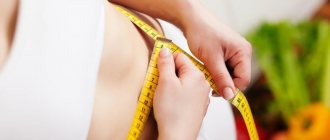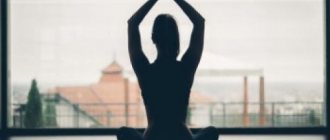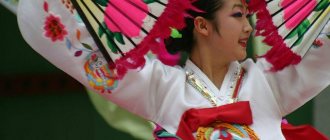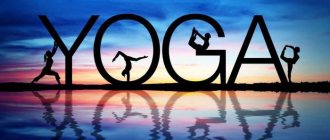The best yoga exercises for legs and buttocks
Includes twelve yoga asanas that are aimed exclusively at working out problem areas. If you do this complex every day, you can soon forget about fat on your legs and buttocks. The main thing is not to give up practice and continue practicing as a preventive measure. In addition, it will have a positive effect on your overall physical fitness and mental balance.
Utkatasana
Performing this asana actively connects the leg muscles to the work. The buttocks and thighs are subject to the greatest load. The pose imitates sitting on a chair, which in this case is absent, but exists only in the imagination. The lack of support forces you to use your muscles to maintain your own body weight. Your own weight begins to be directed towards tension in the muscle groups of the pelvis and hips. The asana improves tone, trains, and strengthens the leg muscles.
Performance:
Get into the starting position called Tadasana. Bend your knees smoothly and lower your pelvis. The movement should be similar to that of you sitting in a chair or on a chair. Inhale and stretch your arms up above your head. Hold the position for several seconds, making sure your breathing is even, and then straighten up and return to the starting position.
Remember. You must always be attentive to how the body responds to the performance of the asana. Beginners are advised to try to go as low as possible and increase the depth gradually. When the pose begins to be easy, you can begin to sway to increase muscle stretch.
Virabhadrasana II
The pose is aimed at working the legs, but the greatest load falls on the inner thigh, which is an undeniable advantage. For beginners, this asana seems quite simple, but this is only the surface impression. It perfectly works those muscles that remain practically unused in everyday life. The advantage of the exercise is that they are involved in two different ways, and therefore the buttocks are also involved.
Performance:
The legs are spread wider than the hips. The right foot is turned outward, and the left foot is used to maintain balance. The center of the left foot should be in line with the right leg. The pelvis is lowered and the chest is rotated, straightening the arms to the side so that they form a straight line with the shoulders. They look ahead. Constantly monitor the correctness of their position. Breathe strongly, but slowly, and then relax, repeat everything on the other side.
Remember. To achieve better results, you need to work on stretching, lowering your pelvis as low as possible. The pose must be collected and balanced.
Natarajasana
One of the most graceful asanas, stimulating and stretching the hip flexors. In the dancing king pose, both internal and external muscles are worked simultaneously. The exercise is aimed at strengthening the lower part of the body, as it requires maintaining balance in a one-legged stance, tensing the muscles from the feet to the pelvis. Thanks to this, the hips open, blocked energy is released, blood flow improves, oxygen and nutrients flow.
Performance:
Become in Tadasana. The right leg is raised and brought back, directed so that the thigh is parallel to the floor surface. Bend the knee, grab the right foot with the right hand and stretch. When a stable position is assumed, the left arm is extended forward. With the palm you can do either Gyan Mudra or hold it straight. They look at the fingers of their left hand, maintain the pose for several minutes, breathing deeply, and repeat the asana on the other side.
Ushtrasana
Asanas help open the chest and hip flexors. Performing the pose has a beneficial effect on the tone of absolutely the entire body, but is mostly aimed at the hips. The front part of the latter is perfectly stretched and stimulated.
Performance:
Take Vajrasana. Raise the hip part and torso so that the thighs and calves form a right angle. Open the chest and bend back. The arms are extended and the palms touch the feet. The head is slowly and smoothly tilted back. Hold the pose, breathing slowly and deeply, and then relax.
Upavistha Konasana
The benefit of this asana is that it challenges and trains the upper legs and also provides a good stretch by engaging the inner thigh muscles, which often receive the least attention. In addition, this pose perfectly develops flexibility, endurance, and strength.
Performance:
Sit in Dandasana. The legs are spread as wide as possible. If you cannot completely straighten your legs to the sides, you need to do this gradually. The arms are extended between the legs, that is, in front. People with good flexibility can bend their body and try to touch their head to the floor. When there is no such flexibility, they simply bend their elbows and relax their neck, while their head hangs freely. Take a few breaths and slowly return to the starting position, moving your legs.
Janu Sirsasana
It is an asana for developing flexibility in the joints of the pelvis and hips. This yoga pose perfectly stretches muscle tissue and stimulates blood flow. Exercise improves nutrition of the femoral muscle groups, which allows you to maintain this area in good tone and excellent shape. The asana is recommended for those who want to strengthen their leg muscles and also increase the size of their buttocks.
Performance:
Take Dandasana. The left knee is bent, placing the foot under the right thigh. The arms are extended upward, the body is bent and the arms are stretched towards the right foot. They inhale air with their stomach and remain in this position, and then repeat all the actions, but on the other leg.
Important. Performing this asana requires that the head touch the knee joint. It will be difficult for beginners to do this, but gradually, of course, it will be possible to achieve this. The main thing is to control the absence of arching in the back. She must be straight all the time.
Baddha Konasana
The exercise is aimed at opening the thigh muscles. His technique involves expanding the range of motion of the hip joints. Getting rid of subcutaneous fat in this area is achieved by increasing the tone and stretching of muscle tissue.
Performance:
A gymnastic mat is placed on the floor. Stretch and then bend the legs at the knee joint. The feet are brought together in the middle, connecting with the soles. The back should remain straight. To hold the pose, grab your feet with your palms, and then begin to press your knees with maximum force to the floor surface. Hold the asana for a few seconds and then relax.
Malasana
Another exercise that has a quick effect on the tone of the muscle groups of the lower extremities, but more specifically the hip ones. By improving blood flow and stretching muscle tissue, the asana tightens the buttocks. Regular practice of this exercise can strengthen, improve flexibility and tighten your thighs.
Performance:
They squat down, bringing their feet together, but without touching the floor surface with their butt. If the position is not entirely comfortable, you can rise on your toes. The palms are brought together and the hands rest on the knees. Try to hold the asana for three breaths, and then relax.
Navasana
This pose must be practiced on a regular basis. It not only improves the physical shape of the hips and buttocks, but also has a positive effect on internal organs, bones and the nervous system. Balancing the entire body weight on the gluteal muscles results in literally the entire body being involved. In addition, concentration and willpower are required, since you have to apply all your perseverance to achieve your goal. Like other asanas, it stretches the muscle groups of the lower extremities and has a positive effect on blood flow.
Performance:
Take the position of Dandasana. Raise straightened legs above the floor surface and find a balance point, and then lift your arms off the floor and stretch them in front of you. The main goal is for the legs and arms to form a Latin "V". Inhale and exhale deeply, and then relax.
The best yoga exercises for legs and buttocks
Utkatasana
Also known as Chair Pose
Benefits - This asana stimulates the muscles of the legs, especially the thighs and buttocks. Sitting in a chair is easy, but not in an imaginary chair where you use your muscles to support your body weight. You use your body weight to tighten the muscles in your hips and pelvis. This not only tones and trains the legs, but also acts as a general strengthening exercise, that is, it is yoga for strengthening the muscles.
Virabhadrasana II
Also known as - Hero Pose II
Benefits - This asana definitely works the entire legs, but especially the inner thighs. This pose may seem simple at first, but it actually works muscles that are not used as often in everyday life. The best thing about it is that you work both legs at the same time in different ways, so this asana works more different muscle groups - perfect for people who want to learn how to get a bigger butt.
How to do it: Place your feet slightly wider than hip-width apart. Turn your right foot outward and use your left foot to maintain balance. The middle of your left foot should be in line with your right leg. Lower your pelvis and expand your chest, straightening your arms so that they form a straight line with your shoulders. Look forward and make sure that the pose is performed correctly. Breathe slowly and forcefully while doing this, then relax. Repeat for the other side.
Natarajasana
Also known as Dance King Pose
Benefits - This graceful pose stimulates and stretches the hip flexors. The muscles of both the internal and external sides are involved. This asana strengthens the lower body as you have to balance on one leg. From the pelvis to the feet, every muscle tenses and stretches. The hips open and all the energy blocked in the legs is released. Blood circulation improves, which means an influx of oxygen and nutrients to them.
Ushtrasana
Also known as Camel Pose
Benefits - This asana is great for opening up your pectoral muscles and hip flexors. It also tones all parts of the body, especially the thighs. This asana works the front of the body so that the muscles in the front of the thighs receive excellent stretching and stimulation.
Upavistha Konasana
Also known as - Sitting Angle
Benefits – This asana works great on the upper part of your legs. In addition to being a great stretch, it also focuses on the inner thighs, which are often overlooked. Increases strength and flexibility.
Janu Sirsasana
Also known as – Head on Knee Pose
Benefits - Janu Sirsasana helps develop flexibility in the hips and pelvic joints. It stretches muscles and improves blood circulation. This helps nourish the muscles and maintain health in that area. This asana also strengthens the legs and is good for enlarging the buttocks.
Baddha Konasana
Also known as – Cobbler Pose, Butterfly Pose, Bound Angle Pose
Benefits - This asana is a great way to open up the hips. This expands the range of motion of the pelvic joints. Stretches and tones the inner thighs, promotes muscle health. This asana works the hips and pelvis, and literally works wonders there.
Malasana
Also known as Garland Pose
Benefits - Malasana is another pose that has an immediate effect on the leg muscles, especially the hips and pelvis. It improves blood circulation and stretches surrounding tissues, ideal for a firm butt. It opens the hips and strengthens the muscles, making them strong and flexible.
Navasana
Also known as Naukasana, Boat Pose
Benefits - If you practice this asana regularly, it will affect not only your body, i.e. organs, nerves, bones and muscles, it will penetrate into the very center of your being. When you have to balance your entire body weight on your buttocks, your entire being begins to tremble. But lo and behold, you apply strength and persistence, and after a few seconds of concentration, you achieve your goal. The asana has a great effect on blood circulation and also stretches the legs well.
Salabhasana
Also known as – Locust Pose, Grasshopper Pose
Benefits - This is an effective yoga exercise to burn fat from the thighs and buttocks and also works many other parts of the body. Strengthens the legs and improves blood flow so the lower body remains strong, flexible and healthy.
Hold the pose for a few breaths before lowering to the floor.
Setu Bandhasana
Also known as - Bridge Pose
Benefits – This asana improves blood circulation. Stimulating muscles in this way tones them, while opening and releasing internal energy.
Ananda Balasana
Also known as Contented Child Pose, Dead Bug Pose
Benefits – This asana is one of the best yoga poses for the hips and pelvis. It is designed to open the pelvic girdle. The hip flexors are worked, the entire inner part is stimulated and stretched. This asana also focuses on those back muscles that we often ignore. The best thing about this pose is that while you're in it, you can customize it until you feel what works best for you.
Have you ever tried these exercises to reduce the size of your hips and buttocks? Keeping your legs flexible is very important. You can complain about fat, but if you don't work on muscle tone, it can lead to much more serious problems. Don't wait for it to happen! Do yoga! Hip and pelvic stretches are fun and help strengthen your muscles and tone your butt.
What are the benefits of yoga for weight loss? Does it even work?
Certainly. Especially if the approach to it is appropriate. Yes, there are different types of yoga - one may be more “energetic”, another more measured, but you need to understand how yoga promotes weight loss? She does this by restoring balance in the body. Any “unauthorized” fat deposits - be they in the hips and waist or anywhere else - are usually the result of an internal imbalance. If you bring your body into harmony, the excess fat will go away (no, it won’t all go away - the body needs something to warm itself up). That's all yoga for losing weight in your legs, or rather, the principle of its action. Now let's get specific.
Important conditions for success
In order for yoga classes to give the desired result and help get rid of cellulite, in addition to physical activity, you should regularly carry out cosmetic procedures. Massage, hot wraps, contrast showers, special creams, scrubs help improve the condition and tone of the skin.
To reduce excess body weight, orange peel in the thighs and buttocks, you need the right diet - you need to eat a balanced diet, give up fatty, fried foods, processed foods, sweet carbonated drinks, fast food, and confectionery. Food must be healthy and must contain vitamins and proteins.
Advice! Add 1-2 tsp to porridge for breakfast and to yogurt or kefir in the evening. fiber powder. This greatly helps intestinal function and cleansing of toxins.
Smoking, alcohol, chronic stress, and lack of sleep negatively affect the condition of the skin and disrupt metabolic processes in the body. Therefore, to improve the effect of yoga, you should lead a healthy lifestyle, adhere to a constant daily routine, and sleep at least 6–8 hours a day.
Yoga classes at home for slimming thighs
Following are 12 easy yoga poses that you can do at home. I’ll say right away that WHEN EXACTLY you will gain slender and elastic thighs is unknown, because everything depends entirely on you, i.e. on how you follow the key success factors which are:
- Regularity of practice (ideally every day or at least 3 times a week)
- Gradual development (take your time)
- Focus (when doing yoga, don't do anything else)
- Relaxation (no, well, the muscles, of course, will tense, but in general, you should try to relax in the final poses, unless otherwise indicated).
If the poses don't work out well at first, don't worry! Over time, everything will work out, well, that is, they will turn out a little better. And by the way, don’t forget to breathe!
So, let's go, the "hips" are waiting!
Exercise 1: Chair Pose (on which one sits) - Utkatasana
It looks simple, but chair pose can still require a lot of effort on your legs, especially at the initial stage (which, in general, is what we need). Over time it will become easier, flexibility will also increase.
Technique: Stand straight with your feet together. As you inhale, raise your arms above your head. Keeping your arms overhead, as you exhale, bend your knees until you reach a position as if you were sitting on a chair (which, in fact, you are not). That is, you need to reach a position where your knees are bent at approximately 90 degrees. Keep your knees together. This may be difficult to do at first, so bend to an acceptable angle. This is the final position.
Stay in the final position for 30-60 seconds, breathing evenly, then as you exhale, return to a standing position, inhale, and as you exhale, lower your arms to your sides. You can repeat it 3-5 times, just don’t overexert yourself.
Exercise 2: Pavanmuktasana (variation)
Lie on your back, arms along your body, legs almost together. Relax. Close your eyes.
As you inhale, lift your left leg so that it is perpendicular to the floor (or as much as you can), with your foot “looking” at the ceiling. At this time, do not lift your right leg off the floor (but try not to strain your right leg).
As you exhale, tensing your abdominal muscles, bend your left leg at the knee so that your thigh reaches your chest. At the same time, clasp your left foot with your hands, raise your head, and touch your left knee with your nose. Hold for 5-10 seconds (you can hold your breath or breathe normally).
Take a deep breath and lower your head to the floor. As you exhale, straighten your left leg and lower it to the floor. Repeat the same with your right leg.
Exercise 3: Deep Squats
Stand straight, feet 30 cm wide, arms forward, in front of you, parallel to the floor, palms facing down.
Inhaling deeply, squat down and try to keep your knees bent at a 90-degree angle. After a full squat, exhale and immediately return to the starting position.
Exercise 4: Ananda Balasala or Happy Child's Pose
The exercise is relatively simple. But it is better not to do it on a hard floor.
By the way, there is an exercise with a similar name, but a different technique - child’s pose (Balasana).
So, lie down on your back. As you exhale, bend your knees and bring them to your chest. Grab your feet with your hands (closer to your toes). Your hands should be in front of your shins, and you should hold your feet on the outside.
Inhale, and as you exhale, pull your feet towards you, while “spreading” your shoulders on the floor. Continue moving towards yourself, spreading your knees towards your armpits. The ankles are above the knees.
Stretch your back along the floor, trying to touch the floor with your tailbone. In the final position, hold for a minute if possible, breathing normally, then, as you exhale, gradually release your feet, straighten your legs, and relax.
Exercise 5: Virabhadrasana 1 or warrior pose (option 1)
Virabhadrasana perfectly strengthens the legs and removes excess fat from the waist and hips. Stand up straight. As you exhale, spread your legs apart, about a meter apart.
As you exhale, turn your left foot 90 degrees (toe points to the left), and your right foot a little (45 degrees).
Inhaling, raise your arms above your head, palms together, and as you exhale, turn your torso to the left 90 degrees and bend your left leg again to an angle of 90 degrees, moving your body forward (i.e., to the left of the original position). Hold in the final pose for 3-5 full breaths (inhale-exhale), then as you exhale, straighten your left leg, return to the starting position, then do the same to the right side (you can keep your arms raised up).
Exercise 6: Virabhadrasana 2
The principle of execution is the same as in warrior pose 1, only in the final position we hold our hands not above our heads, but to the sides, parallel to the floor. This pose is called Virabhadrasana 2.
Best Yoga Poses for Weight Loss
Common methods of losing weight: massage gels, creams or tablets. At first, they seem to be effective, but they are not long-term. Yoga tones and stretches body parts, stimulates metabolism, and burns calories. Here is a set of exercises for beginners, it will help you adjust your weight, make your stomach flat and tone your muscles. Do it regularly, and the results will not keep you waiting.
Warrior Pose:
Virabhadrasana reduces weight, strengthens and tones the arms, shoulders, hips and back muscles at the same time. It helps people with back problems and is useful for improving balance and endurance. Stand straight with your feet far apart. Raise your arms above your head and straighten them.
Place your hands in namaste and turn your torso to the right side. Bend your right knee, trying to stretch your abdominal muscles as much as you can. Close your eyes and count from 30 seconds to 1 minute. After turning to the right, perform the exercise to the left. This pose will tone and tighten the leg muscles. Repeat the pose 2 to 3 times on both sides.
Warrior Pose II:
Warrior Pose II is an abdominal and thigh exercise that opens, strengthens and tones the thighs and works the abdominal muscles. The pose increases stamina and concentration. This pose, just like the one above, strengthens the stomach and legs, but nevertheless, it is done differently. Stand straight with your feet far apart. Now move your right leg to the right side and bend your knee so that your thigh is parallel to the floor. Stretch your arms out to the sides and keep them parallel to the floor. Then look to the right. Freeze in the pose for 30 seconds to 1 minute and return to the starting position. Repeat on the other side. Do the exercise 2 to 3 times on both sides. While performing the asana, the abdominal muscles are tense.
Chair Pose:
Utkatasana is the best exercise for the hips, strengthens and tones the muscles of the buttocks, thighs, back and chest. Trains ankle and knee muscles. Thanks to the asana, the lower back is strengthened. In this position, the body looks like a chair and the pose requires stamina. You may feel pain in your legs the first couple of days after practice. Repeating it regularly will increase flexibility and pain will disappear.
Place your feet together. At the same time as you inhale, raise your arms above your head. Stretch them up and slightly bend your knees, exhale. Stay in this position for 60 seconds, breathing normally. Yes, it will be difficult to stay in this position for a long time, but try to hold it until you feel tired. Do the exercise 10 times a day and increase the number every 3 days.
Boat Pose:
A powerful pose to tone the transverse abdominis muscle. Sit on the mat and stretch your legs. Draw your knees in, keep your hips tightly closed, and your toes point forward. Now lift your legs off the ground and raise them at a 45 degree angle. Inhale and straighten your legs. The spine is straight and the body is in a V shape. Raise your arms to shoulder level. Hold for 30 seconds. Exhale slowly and return to the starting position. The pose increases endurance and reduces belly fat.
Butterfly pose:
Cobbler's Pose or Baddha Konasana is a simple and easy exercise that can be done by any beginner. The asana tones the lower body, stimulates the abdominal muscles, stretches the inner thighs, knees and groin. Helps cure infertility, asthma, depression and anxiety. Sit up straight, back straight. Spread your knees and point the soles of your feet toward each other. Hold the pose for a minute.
Locust Pose:
Locust Pose or Salabhasana is one of the best poses for weight loss. The pose increases strength and flexibility of the back, arms and legs, and tightens the buttocks. Stretches the shoulders, chest and abdomen. Lie face down with your palms facing the ground. As you inhale, raise your legs without bending your knees. Raise your upper torso and arms up, stretching your abdominal muscles. Balance yourself on your tummy. Thanks to salabhasana, fats around the thighs will decrease and the muscles of the legs will stretch.
Camel Pose:
Camel Pose or Ushtrasana focuses on three problem areas of the body - the stomach, back and hips. The pose opens the chest and lungs, improves the flexibility of the spine, abdominal cavity and neck, stimulating the thyroid gland.
Place a soft cloth underneath to prevent pain. Sit on your knees and place your hands on your hips. Then slowly kneel down. Bend back and stretch your chest and stomach. Hold this position for 30 seconds and return to the starting position. Repeat the asana 3 to 4 times. Exercise is beneficial to melt fat in all areas of the body.
These exercises will help stretch the muscles around your hips, waist, abdomen, legs and arms. Combine the poses with a balanced diet, and they will have a tonic effect on the figure, improve digestion, and relieve stress and nervous tension.
Exercise 7: Setubandhasana or Bridge Pose
Bridge pose is not difficult. Lie on your back, arms by your sides, legs resting freely. Bend your knees and place your feet next to your butt. As you inhale, lift your pelvis off the floor so that the bend in your knees reaches approximately 90 degrees. The head and neck remain on the floor, the hands also rest on the floor (they can be joined together).
Hold this pose as long as you feel comfortable, breathe normally, then exhale and return your body to the floor, straighten your legs, and relax.
Exercise 8: Adho Mukha Svanasana or Dog Pose (variation)
Read more here: Yoga Dog Pose
You perform the usual downward-facing dog pose, while in the final position, as you exhale, lift first one leg, then the other, in turn. Hold the position with your leg raised for 3-5 breaths.
Exercise 9: Baddha Konasana or Shoemaker Pose (Butterfly Pose)
The full version of this asana can be challenging for most yoga beginners, so just try to do it as best as you can.
Technique: Sit on the floor, pull your legs towards you so that your feet touch. Now try to bring your feet closer to you - ideally, they should be right next to your perineum. Alternatively, you can try to approach the folded feet yourself using your hands, but be careful.
When you reach the final position, as in the photo, stay there as long as you are comfortable, breathing freely. Then slowly straighten your legs and shake them gently.
Exercise 10: Shalabhasana or locust pose (variation)
Lie on your stomach. Arms along the body, legs together. As you exhale, lift your head, shoulders, arms, chest and legs above the floor. Hold for a few seconds and inhale as you lower yourself to the floor. When lifting, the lower abdomen always remains on the floor.
Repeat the pose 3-5 times, but do not overexert yourself. If you have high blood pressure or heart or back problems, be especially careful. This is a variation of the locust pose; Usually the hands are placed on the floor.
Exercise 11: Warrior Pose Variation
Assume Virabhadrasana 2, then gently bend back, placing your left hand on the back of your left leg and lifting your right above your head. Hold for 3-5 breaths, then repeat on the other side.
How the exercises work
The exercises used in yoga are not as intense as in regular gymnastics or exercises. Therefore, the possibility of losing weight using this technique is often questioned. The point here is an integrated approach: the development of body and soul. When you are mentally and physically healthy, your weight returns to normal. Asanas help achieve balance in the body and mind.
By performing asanas, we control the flow of energy flowing into our body. Let's consider techniques suitable for losing weight:
- Ashtanga – dynamic exercises;
- Kriya – poses that last for a long time;
- Hatha – static classical asanas;
- Iyengar – classic calm asanas;
- Yoga 23 – a complex of hatha and martial arts of the east;
- Critical alignment - to strengthen the inner layers of muscles.
Such techniques remove excess toxins from the body, improve metabolism, which leads to weight loss, and in addition, muscles develop. Developed muscles provide good motor skills, control of temperature and heart function. In addition to effective exercises, yoga carries an interesting philosophy that helps to find solutions to any problems, since practice leads to a harmonious order of mind and body. In addition, yoga helps to improve the health of internal organs, which is very important for female reproductive function.
Yoga lessons for weight loss
Yoga uses several types of exercises:
- motor
- respiratory
- cleansing
Together they give the necessary effect, improving metabolism in the body, healing the whole body. Along with excess weight, fatigue, drowsiness, and apathy go away.
Before starting classes, you need to find the right clothes that will not restrict movement, prepare a mat and ventilate the room well. Since you will be breathing a lot and correctly, it is necessary that the air is fresh. You can study in a group or at home using video courses, it all depends on your preferences. Ideally, the group should not exceed 10 people, so that no one interferes with each other.
Yoga for weight loss - reviews
Reviews about weight loss are always very contradictory, so you shouldn't always rely on them. Depending on the constitution and physical fitness, each body perceives the load and reacts to it in its own way. For some this is very difficult and does not bring quick tangible results, for others, on the contrary, they discover a completely new interesting world. There is only one way to find out how it will be for you.
Basic rules in yoga
Before you start studying, you need to learn the rules, without which quality lessons will not work:
- You cannot exercise only after waking up from sleep or not in a vigorous state.
- You should not perform asanas before bed, because they tone you up.
- Exercises can be done 2 hours after meals.
- Fresh air is a great benefit for exercise.
- Clothes should not be restrictive, but should be loose.
- Gradual loads. Do everything thoughtfully, the main thing is regularity.
- It is advisable to achieve a frequency of training 3 times a week, performing asanas for 20-30 minutes.
- Don't be distracted by outside factors.
- Always breathe slowly and evenly.
- Don't be nervous or worry, don't think about anything.
When all the rules have been studied and applied in practice, you can begin.
Yoga for weight loss
A typical workout consists of strength or cardio exercises that force you to actively strain your muscles, push yourself, and sometimes scold you for being slack or having an extra bun. Loud energetic music sounds around you, which spurs you on and pushes you to new feats. The atmosphere is quite stressful, both for the body and for the internal state. Not everyone will find such a rhythm pleasant and comfortable.
Yoga gives you completely different sensations; after all, this type of practice works for relaxation. Here no one will rush you or put pressure on you. The weight will come off more slowly, but the likelihood of it returning will be lower.
Preparing for work
Start with 2 minutes of easy running in place. Inhale and exhale 3 times. With your knees bent, lean forward, relaxing your neck and back. Inhale and straighten your legs, supporting them with your hands. Gradually straighten your back, keeping your lower back straight. Bend over again with your legs bent. As you inhale, bend down again. Round your back and raise your arms, stand up yourself. Lower your arms while exhaling. Now you can start performing asanas.
Chair Pose
Standing straight, press your feet together. Hands up and clasp your palms. Squat to a right angle. Stand straight. Pull your spine up and your shoulders down. Wait 2-5 minutes and then slowly stand up as you exhale.
Locust Pose
Lie on your stomach and raise your arms up. Stretch your arms, head, legs, chest without lifting your stomach. Lift and tighten your buttocks. Stay in this position for as long as you can. This exercise is good for the whole body, including losing weight in the buttocks.
Candle pose
It's called "birch tree". Stay in this position as long as you can. But you shouldn’t get up abruptly: first lie down for the same amount of time as you were in this position. This asana is good for strengthening the thighs and getting slender legs.
Effective exercises for buttocks, legs and thighs
In order to burn fat on your calves and thighs, we recommend performing an effective workout.
Warrior Pose
- Step forward and sit down. Bend either leg at a right angle.
- Press your heel firmly into the floor while straightening your other leg.
- Bend your arms at chest level, palms should be clenched into fists, elbows back.
- Straighten your body and stand.
- Stand until it burns. Then repeat for the other leg.
Now about yoga, which is used to lose weight in the buttocks.
Flying eagle
- Place your feet shoulder-width apart and your right hand forward.
- Squat down while inhaling, placing your hands on your waist.
- Exhalation. Extend your left arm forward, your right arm back, lift your bent right knee up.
- Hold this position for no more than 40 seconds, then change legs.
Kundalini yoga
These are movements and meditations that are organically combined. In addition to a slim figure, practice clears the mind and teaches you to control your thoughts. It is good because it has no contraindications. Now let's talk about what you get by doing this technique:
- Flexible and resilient body, ready to overcome many obstacles;
- Self-discipline, good resistance to stress;
- Strengthening the immune, reproductive, nervous, digestive, musculoskeletal systems;
- Unlocking creative and spatial potential, good intuition;
- Increased awareness.
Purposefully engage in this practice and you will not only be able to lose weight, but also improve your health, put your inner world in order, and begin to live in harmony with the world and with yourself.
Completing the exercises
At the end of classes, you need to relax, which the asanas described below will help you with.
Child's pose
Sit on your knees, heels under your buttocks, lower your body down, stretching your arms forward. Stay in this position for up to 3 minutes.
Half Bridge Pose
Bend your knees while lying on your back. Feet are closer to the buttocks, placed shoulder-width apart. Straighten your arms under the shoulder joints, cross your fingers, extending your hands towards your feet. Raise your pelvis as high as you can. The crown rests on the floor. To make it easier, support your lower back with your hands. Stand like this until the first signs of fatigue.
Comfortable position
Sitting on the floor, press your left foot to the top inner surface of your right leg. Bend your right leg so that it lies parallel to your left. Keep your back straight and sit for up to 3 minutes.
In addition to these exercises, you can simply relax: just lie quietly or rock on your back with your knees pressed to your chest.
A set of such exercises forces all ligaments and muscles to work, which promotes weight loss and helps the body be healthier. Regular exercises correct the relief of the body and correct figure flaws. You can achieve high results that cannot be achieved with conventional strength training.
Effective yoga for weight loss
Yoga is not just a set of exercises, it is a whole philosophy. By trying simple weight loss exercises, you will feel your body begin to change. To make the effect more pronounced, do not forget about the need to drink plenty of fluids, avoid night snacks, fatty foods, sweets and starchy foods.
Yoga can open up new possibilities for your body and help you find harmony and calm. You can lose weight with yoga, but it will take more time compared to regular workouts in the gym. Good luck in your fight against excess weight!
Contraindications
A number of certain diseases interfere with yoga practice, so be sure to consult your doctor. Among the contraindications for practicing yoga are the following:
- Yoga should not be practiced by people with high blood and intracranial pressure, as well as those who suffer from diseases of internal organs.
- Presence of traumatic brain injuries, spinal injuries, hernias.
- People who have had a stroke or myocardial infarction should postpone classes for up to six months.
- 4It is not recommended to perform exercises for women during the menstrual cycle, as well as for those undergoing surgery in the abdominal or chest area. After operations, you need to wait 3 months before starting classes.
- Influenza or colds with elevated body temperature.
- Pain in the neck, back and lower back. First cure them, and then deal with them with the permission of the doctor.
- If you feel worse, you should change your practice or consult about the correct training at home.
So, now we know a lot about yoga: what it is needed for, what characteristics it has, what underlies it. It is naive to think that this is ordinary gymnastics that strengthens the abs and develops tightening of the hip joint. In fact, this is a whole system that helps you become healthy and successful.
Are there any contraindications for doing yoga?
Like any type of physical activity, yoga has some contraindications:
- high blood pressure;
- hernia of the abdomen, spine;
- period of exacerbation of chronic diseases;
- arthritis, arthrosis;
- severe diseases of the cardiovascular system;
- sprained muscles, ligaments;
- increased body temperature;
- mechanical injuries of the back and joints.
Attention! During menstrual periods, women are allowed to do only simple exercises that do not involve the abdominal muscles, otherwise bleeding may increase and pain in the groin area may appear.
If you have a history of chronic diseases, you should consult your doctor before starting yoga classes. You should not perform asanas when physical activity leads to a sharp deterioration in well-being.











